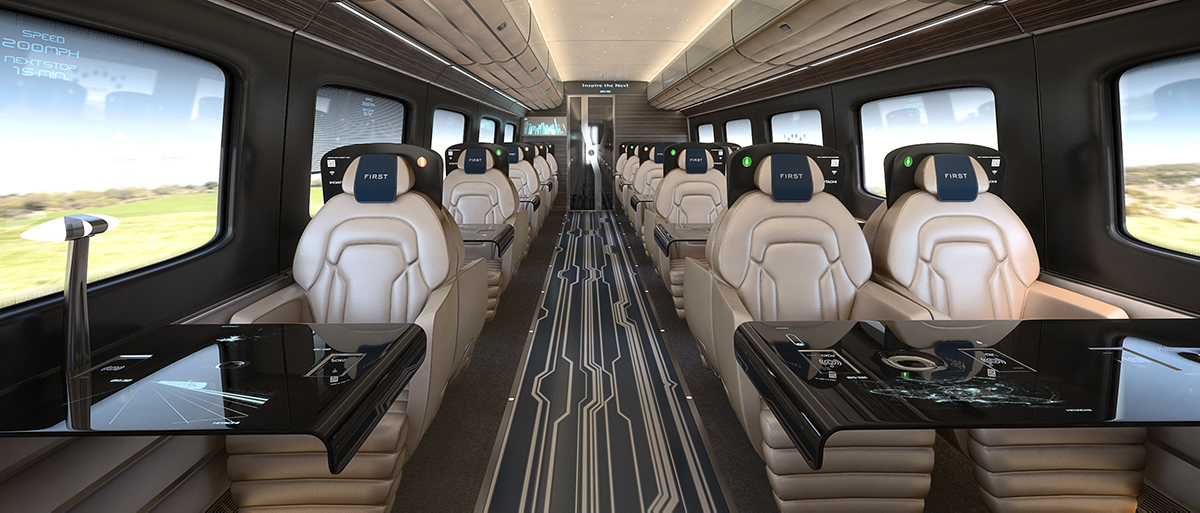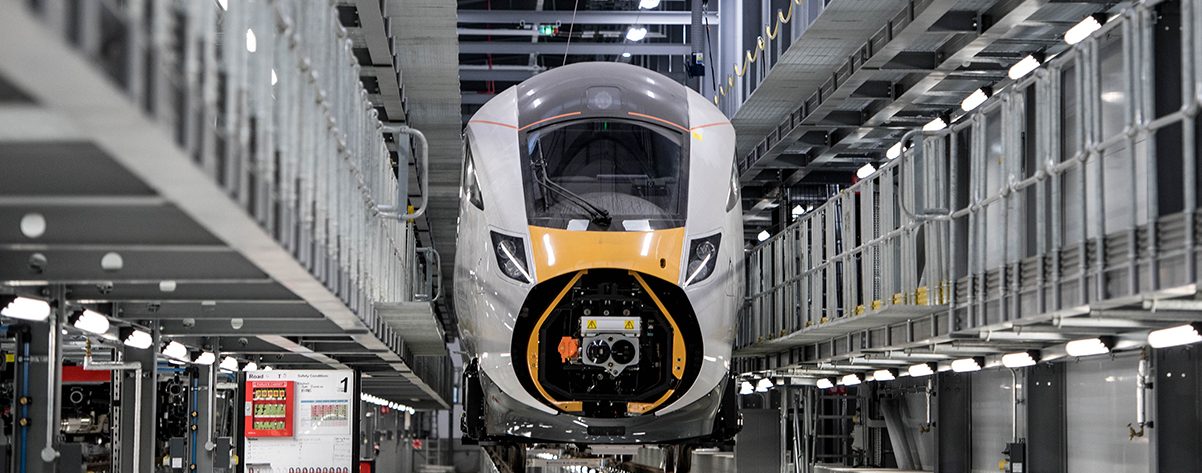It was British technical excellence that gave birth to the world’s first steam locomotive in 1803. More than two centuries later, Japanese technology has transformed rail systems and is part of the most advanced trains on the planet. The crossing of these tracks led Hitachi Rail to choose the UK as its home base. But anyone who assumes that the innovation side of the equation is a one-way trip from Japan might be more than a bit surprised.
History
Back in 1926, a senior engineer from Hitachi’s railways division arrived at Southampton aboard a passenger steamer and visited a number of rail firms across northern England. Eighty-nine years later, the Japanese giant brought things full circle by establishing a train factory in County Durham—the spiritual home of the railway industry but a place showing few indications of that history. The last train factory had shut down decades earlier.
“Hitachi’s rail heritage stretches back almost a century, back to the first steam trains in Japan. Those were aided, in part, by that Japanese engineer’s visit to the UK, and then the development of the first shinkansen trains ahead of the Tokyo Olympics in 1964,” said Andrew Barr, global CEO of Hitachi Rail, in an interview with ACUMEN. “It is a proud and impressive legacy, and Japanese technological expertise will always be a core aspect of our business offer”.
Hitachi began establishing a railway business in the UK in 1999, bidding for projects and vehicles as the sector expanded. Its major breakthrough came when the firm won the bid to build Javelin HS1 trains, to be delivered ahead of the London 2012 Olympic and Paralympic Games. The trains and lines went into operation six months ahead of schedule. Hitachi now has a depot in Ashford, Kent, and Javelin trains have halved journey times between London and Kent, making them extremely popular with commuters.

Queen Elizabeth alongside a Hitachi train bearing her name. PHOTO: HITACHI RAIL EUROPE
Right track
The first Javelin trains were introduced onto British tracks in 2009, and the government was so impressed by their performance that, three years later, Hitachi won the £5.7bn contract for the Intercity Express Programme, the largest contract in the firm’s history. The project was also a factor in the firm’s decision to place its global headquarters in London.
“Before the Javelin trains that first began running in the UK in 2009, Hitachi Rail’s presence outside its core market was small,” said Barr. “So, when Hitachi Rail moved its global headquarters to London, it reflected the firm’s ambition to be a truly global player in the rail sector”.
Under the contract, Hitachi is building and maintaining 122 new intercity trains for the East Coast and Great Western main lines. The firm is also setting up its County Durham manufacturing facility in Newton Aycliffe. The plant has 700 employees and the £100mn investment has sent ripples throughout the region. Fully 70% of all components fitted at the factory are manufactured within 40 miles of the plant.

Conceptual interior for Hitachi’s very-high-speed train shown at the Railtex expo. PHOTO: HITACHI RAIL EUROPE
Expanded network
The commitment to maintenance has also led to the creation of a nationwide network that will see 13 depots—including ones in Doncaster, Bristol and Wales—become operational by the end of 2020. At that point, Hitachi Rail will have 281 trains running in the UK, including 70 electric commuter trains for ScotRail and 65 Intercity Azuma trains for London North Eastern Railway. These 13 facilities will maintain trains for the next 27-and-a-half years.
“In the past five years, Hitachi has made the shift to being a global business, and London has been at the heart of that,” said Barr. “The move made sense with so much growth in the European market and major UK projects, such as the Intercity Express Programme. It was a huge sign of trust in the UK team and the leadership of Alistair Dormer, my predecessor, and has proved really successful”.
In 2015, Hitachi acquired the Italian train builder AnsaldoBreda S.p.A., which has locations in Rome, Naples and Tuscany. But the firm remains committed to retaining London as its global headquarters despite the shadow of Brexit looming large over all sectors of the British economy and the nation’s trade relationship with the rest of Europe.
UK success
The London base of operations has “proved extremely successful” as Hitachi Rail continues its global integration project, Barr said. The firm continues to grow its presence throughout the world in rolling stock, signalling, services and maintenance contracts, as well as turnkey projects.
Barr points out that there are currently record levels of investment in the UK rail sector. Passenger numbers have doubled since train operators were privatised in the early 1990s, and there is strong demand to increase capacity, which requires new trains.
Not all the innovations in the UK operations—in the design and manufacturing of new trains or in the office environment—are imported from Japan. Friction stir-welding is one example. This joining process for metals was first devised in the UK and then noticed by Hitachi’s experts, who adapted it for mass production in the railway sector. Today, the process is used in the construction of shinkansen trains because it creates exceptional strength—even in the lightweight extruded-aluminium shells that the trains use.

Boswell has worked to introduce more diversity to Hitachi Rail. PHOTO: HITACHI RAIL EUROPE
Collaboration
Equally, the British and Japanese sides of the equation have worked together to create the world’s first “bi-mode” passenger train that requires no locomotive. The vehicle, which has already been earmarked to operate on British lines, has electric as well as diesel modes and can switch between the two power sources at the push of a button—even while travelling at speeds of more than 160kph.
The technology means that this new generation of trains can run to destinations that do not have electrified infrastructure, benefitting millions of travellers.
The amalgamation of the best of British and Japanese know-how has also been felt in the workplace. Barr underlined that the Japanese business “has benefitted from UK and international business culture, such as changing office space to become ‘hot-desking’ and introducing more flexible working hours”.
Equally, Karen Boswell, managing director of the UK business, is “a champion” at getting the best people into the business. That includes fostering more gender diversity.
“She has led a series of business meetings and programmes to explore how we can get the best out of all our workforce and encourage new talent,” Barr said. “She has also held women-only roundtable meetings to discuss gender issues in the workplace. Change and integration always take time—and you have to bring people along with you—but, without a doubt, we will be stronger for becoming one globally integrated business”.
The immediate aim, he added, is to win more orders for the Hitachi factory. When he met with ACUMEN in late March, Barr was awaiting news in the firm’s bid for 54 very-high-speed trains in the £55.7bn High-Speed (HS2) project, the British equivalent of the shinkansen, to operate at comparable speeds and frequency. Phase one of the HS2 railway will connect London and Birmingham and is expected to begin operation in December 2026. The winner of the bid will be announced later this year.
Further down the line, the aim is to bring in other Japanese rail systems, such as digital operations, to British lines to increase capacity and reliability.
“The centres for our key business units are the UK, Japan and Italy. On paper, they have very different cultures, yet it has been remarkable to see us all form one Hitachi culture and embrace the central values of the business,” said Barr.
“We are one global family, with more being done each day to integrate how we work and deliver for our customers. For me, our power to have an impressive offer in rolling stock, maintenance, turnkey, digital and the Internet of Things is really exciting and a great proposition”.









